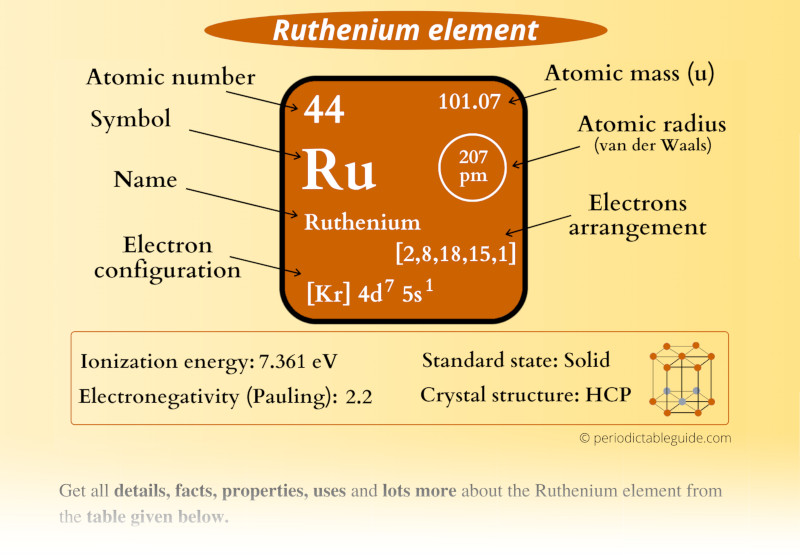
This is a SUPER easy guide on Ruthenium element.
In fact, the table mentioned below is the perfect information box (Which gives you every single detail about the Ruthenium element in Periodic table.)
So if you want to know anything about Ruthenium element, then this guide is for you.
Let’s finish this very quickly.
Ruthenium Element (Ru) Information
| Appearance | 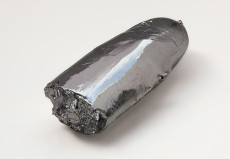 Silvery white metallic luster |
| State (at STP) | Solid |
| Position in Periodic table | 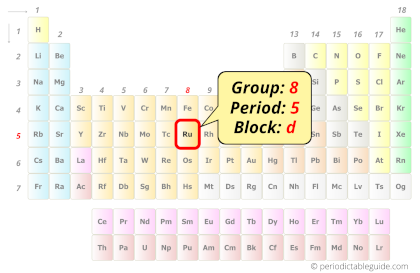 Group: 8, Period: 5, Block: d |
| Category | 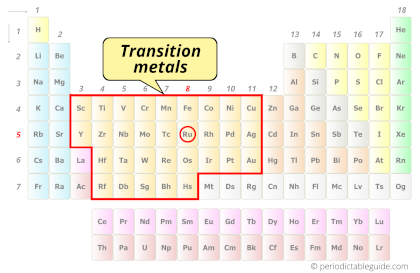 Transition metals |
| Atomic number or Protons | 44 |
| Neutrons | 57 |
| Electrons | 44 |
| Symbol | Ru |
| Atomic mass | 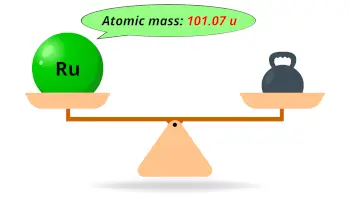 101.07 u |
| Electrons arrangement or Bohr model | 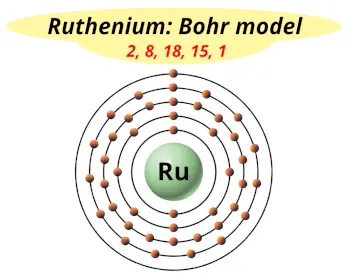 2, 8, 18, 15, 1 |
| Electronic configuration | [Kr] 4d7 5s1 |
| Atomic radius | 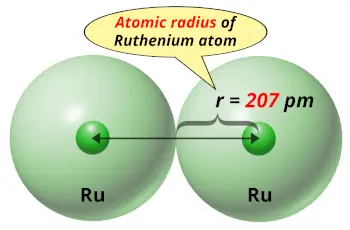 207 picometers (van der Waals radius) |
| 1st Ionization energy | 7.361 eV |
| Electronegativity | 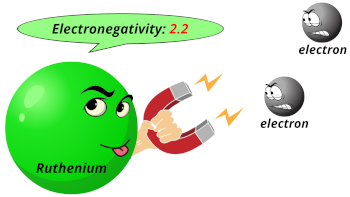 2.2 (Pauling scale) |
| Crystal structure | 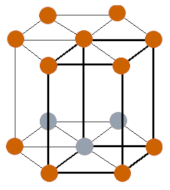 HCP (Hexagonal close packing) |
| Melting point | 2607 K or 2334 °C or 4233 °F |
| Boiling point | 4423 K or 4150 °C or 7502 °F |
| Density | 12.37 g/cm3 |
| Main isotope | 102Ru |
| Who discovered Ruthenium and when? | 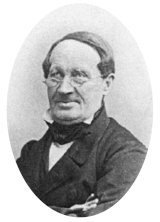 Karl Ernst Claus in 1844 |
| CAS number | 7440-18-8 |
Ruthenium in Periodic table
Ruthenium element is in group 8 and period 5 of the Periodic table. Ruthenium is the d-block element and it belongs to Transition metals group.
| H | He | ||||||||||||||||
| Li | Be | B | C | N | O | F | Ne | ||||||||||
| Na | Mg | Al | Si | P | S | Cl | Ar | ||||||||||
| K | Ca | Sc | Ti | V | Cr | Mn | Fe | Co | Ni | Cu | Zn | Ga | Ge | As | Se | Br | Kr |
| Rb | Sr | Y | Zr | Nb | Mo | Tc | Ru | Rh | Pd | Ag | Cd | In | Sn | Sb | Te | I | Xe |
| Cs | Ba | La* | Hf | Ta | W | Re | Os | Ir | Pt | Au | Hg | Tl | Pb | Bi | Po | At | Rn |
| Fr | Ra | Ac** | Rf | Db | Sg | Bh | Hs | Mt | Ds | Rg | Cn | Nh | Fl | Mc | Lv | Ts | Og |
| *Ce | Pr | Nd | Pm | Sm | Eu | Gd | Tb | Dy | Ho | Er | Tm | Yb | Lu | ||||
| **Th | Pa | U | Np | Pu | Am | Cm | Bk | Cf | Es | Fm | Md | No | Lr |
←Move to: Technetium (Tc) element – Periodic Table
→Move to: Rhodium (Rh) element – Periodic Table
Why is Ruthenium in Period 5?
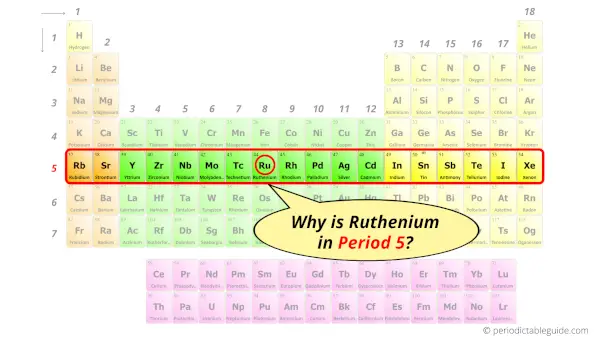
Let me ask you a question.
How many shells does ruthenium have?
It’s 5. Right?
You have already seen the bohr model of ruthenium atom in the above table.
From the Bohr model, it can be found that the number of orbits or shells in ruthenium is 5. Hence, as ruthenium has 5 orbits, it lies in period 5 of the Periodic table.
Why is Ruthenium in d-block?
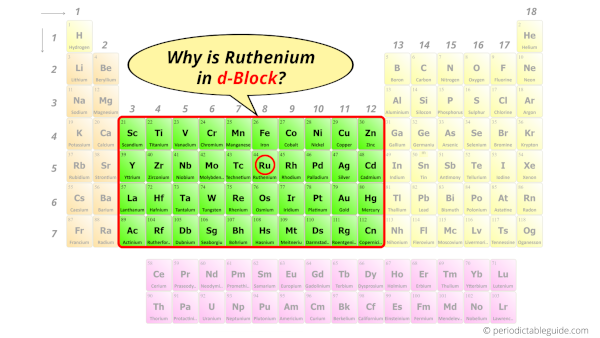
Before knowing this reason, first of all I want to ask you a simple question.
How can you determine the blocks-wise position of elements?
The simple answer: The elements will lie in the s, p, d or f block will completely depend upon the subshell in which the last electron will enter.
For example; the electron configuration of ruthenium is [Kr] 5s1 4d7.
So the last electron of ruthenium enters the d-subshell or d-orbital.
Hence, ruthenium is the d-block element.
Is Ruthenium a Transition Metal? Why?
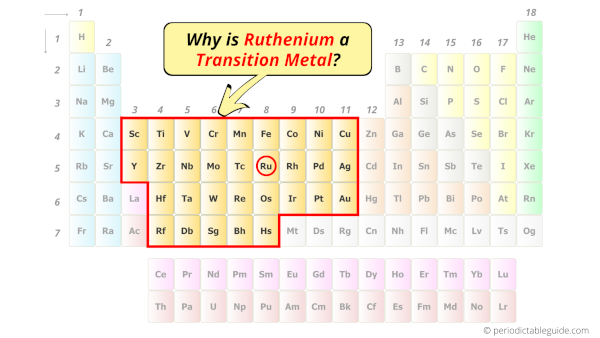
Yes, Ruthenium is a transition metal because it has incompletely filled d-orbital in its ground state.
Let me explain the exact meaning of this.
According to the definition of transition metals;
The element should compulsorily have incomplete d-orbitals, either in their ground state (M) or most common oxidation states (M1+, M2+, etc) then only they are called transition metals.
Now, the ground state of Ruthenium means its normal state in which it has neither gained nor lost any electron/s.
So the ground state of Ruthenium is Ru.
And the ground state electronic configuration of Ruthenium is [Kr] 5s1 4d7.
In this state, if we see the electron configuration of Ruthenium, then it possesses incomplete d-orbitals.
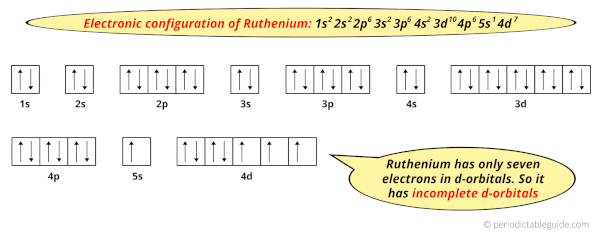
Because, there are only seven electrons in the d-orbitals.
In order to have the complete d-orbitals, there must be 10 electrons in it.
But in the ground state electronic configuration of ruthenium, you can see that it has only 7 electrons in d-orbitals.
Thus, Ruthenium has incomplete d-orbitals.
And hence, as Ruthenium has incomplete d-orbitals, it is considered as a transition metal.
5 Interesting facts about Ruthenium
Interesting facts about ruthenium element are mentioned below.
- The name ruthenium was derived from the word “Ruthenia” (which is a latin word for russia).
- Ruthenium is generally obtained from the mineral deposits from the Ural mountain in North and South America. It is also obtained from the pyroxenite deposits of South Africa.
- The abundance of ruthenium in earth’s crust is around 1 parts per billion by weight, while its abundance in the solar system is believed to be 5 parts per billion by weight.
- Ruthenium metal can be extracted from radioactive waste also.
- Ruthenium was discovered by Karl Ernst Claus in 1844 (in Russia).
Properties of Ruthenium
The physical and chemical properties of ruthenium element are mentioned below.
Physical properties of Ruthenium
Physical properties of ruthenium are mentioned below.
- Ruthenium is a solid metal having Silvery white metallic lustre.
- The atomic mass of ruthenium is 101.07 u and its density is 12.37 g/cm3.
- The melting point of ruthenium is 2334 °C and its boiling point is 4150 °C.
- The crystal structure of ruthenium is HCP (Hexagonal close packing).
- There are many isotopes of ruthenium, but out of them the most abundant isotope is 102Ru (having 31.5 % abundance).
Chemical properties of Ruthenium
Chemical properties of ruthenium are mentioned below.
- Ruthenium has incomplete d-subshells and hence it is classified as a transition metal on the periodic table.
- Ruthenium is a transition metal and hence it has many oxidation states. The oxidation states +2, +3 and +4 are the most common oxidation states of ruthenium.
- Pure ruthenium shows a chemical reaction with halogens as well as hydroxides.
- If ruthenium is kept open in air, it will not tarnish at room temperature.
- 0.1% of ruthenium added to titanium can improve its corrosion resistance property upto 100 times.
Uses of Ruthenium
Uses of ruthenium are mentioned below.
- Ruthenium is used as an alloying metal which improves the corrosion resistance property.
- Ruthenium is added to platinum and palladium to make them hard.
- Ruthenium-molybdenum alloy behaves as a superconductor at a temperature of 10.6 K.
- Ruthenium can also be used as a catalyst to remove hydrogen sulfide during the oil refining process.
Explore our New Interactive Periodic Table (with Rotating Bohr Models and More)

Details about this Periodic table:
- Access detailed info on all elements: atomic mass, electron configurations, charges, and more.
- View rotating Bohr models for all 118 elements.
- Get a free HD image of the Periodic Table.
Note: For future use, bookmark this Periodic table or visit “PeriodicTableGuide.com”
External resources:
- Ruthenium – Element information, properties and uses | Periodic Table. (n.d.). Ruthenium – Element Information, Properties and Uses | Periodic Table. https://www.rsc.org/periodic-table/element/44/ruthenium
- Ruthenium – Wikipedia. (2007, December 10). Ruthenium – Wikipedia. https://en.wikipedia.org/wiki/Ruthenium
- P. (n.d.). Ruthenium | Ru (Element) – PubChem. Ruthenium | Ru (Element) – PubChem. https://pubchem.ncbi.nlm.nih.gov/element/Ruthenium
- It’s Elemental – The Element Ruthenium. (n.d.). It’s Elemental – the Element Ruthenium. https://education.jlab.org/itselemental/ele044.html
- Higgins, S. (2010, November 23). Regarding ruthenium. Nature Chemistry, 2(12), 1100–1100. https://doi.org/10.1038/nchem.917
